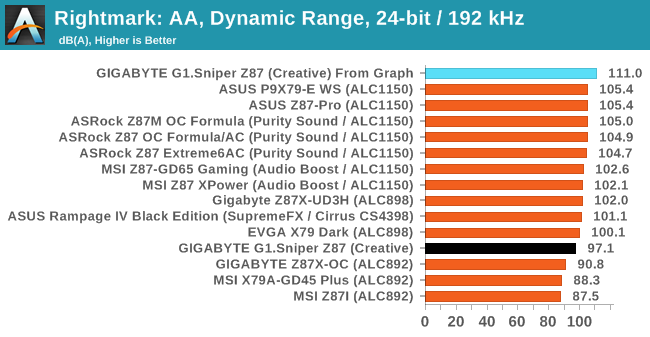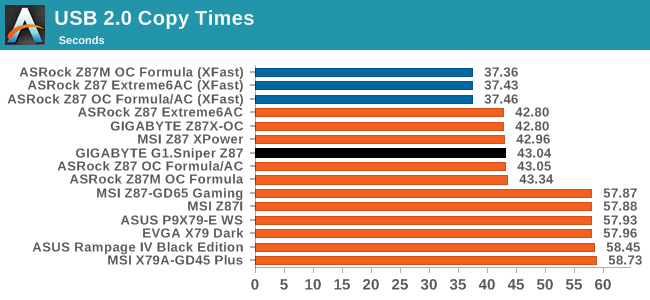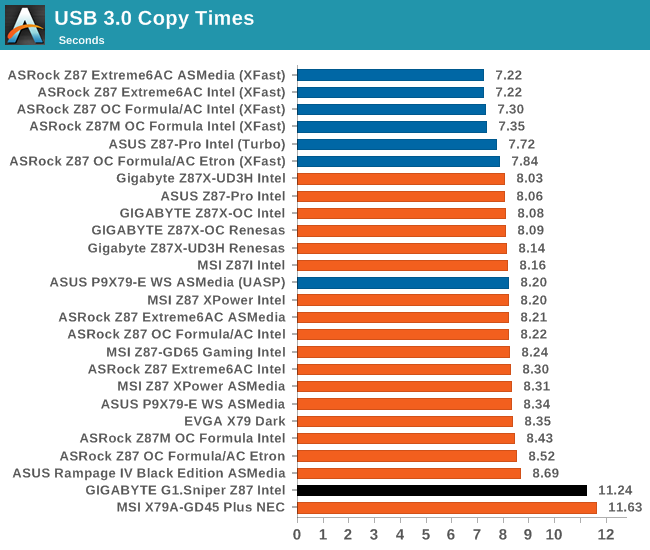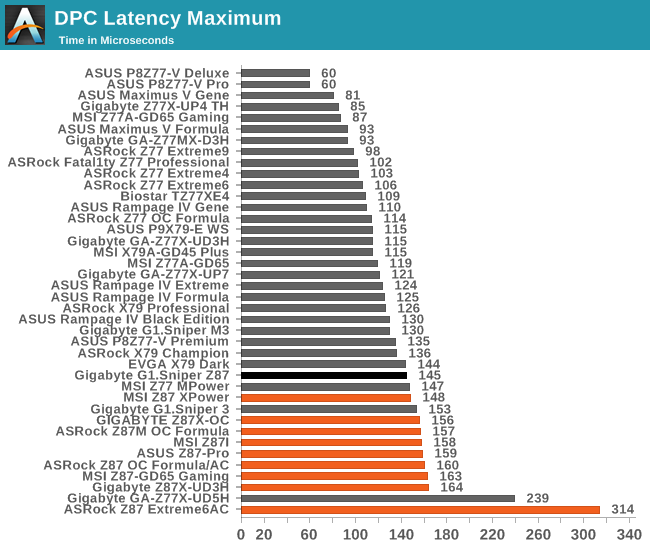GIGABYTE G1.Sniper Z87 Review
by Ian Cutress on February 24, 2014 2:00 PM EST- Posted in
- Motherboards
- Intel
- Gigabyte
System Benchmarks
Rightmark Audio Analyzer 6.2.5
The premise behind Rightmark:AA is to test the input and output of the audio system to determine noise levels, range, harmonic distortion, stereo crosstalk and so forth. Rightmark:AA should indicate how well the sound system is built and isolated from electrical interference (either internally or externally). For this test we connect the Line Out to the Line In using a short six inch 3.5mm to 3.5mm high-quality jack, turn the OS speaker volume to 100%, and run the Rightmark default test suite at 192 kHz, 24-bit. The OS is tuned to 192 kHz/24-bit input and output, and the Line-In volume is adjusted until we have the best RMAA value in the mini-pretest. We look specifically at the Dynamic Range of the audio codec used on board, as well as the Total Harmonic Distortion + Noise.

Dynamic Range of G1.Sniper Z87


The human ear cannot distinguish much beyond 20 kHz, and so audio manufacturers sometimes ignore the performance beyond this point. As we can see in the dynamic range graph, the G1.Sniper Z87 has a great base around -110 dB until we get beyond 20 kHz (ignoring the peak at 1 kHz, the test signal). RMAA is unfortunate that its basic test goes from 17 Hz to 50 kHz, and thus reports a peak at 35 kHz which is outside the range of human hearing. From this point on I feel we may have to report an interpolated value from this graph to counteract RMAA failings, hence why there are two values in the graphs above. This benchmark is continuing to evolve.
USB Backup
For this benchmark, we run CrystalDiskMark to determine the ideal sequential read and write speeds for the USB port using our 240 GB OCZ Vertex3 SSD with a SATA 6 Gbps to USB 3.0 converter. Then we transfer a set size of files from the SSD to the USB drive using DiskBench, which monitors the time taken to transfer. The files transferred are a 1.52 GB set of 2867 files across 320 folders – 95% of these files are small typical website files, and the rest (90% of the size) are the videos used in the WinRAR test. In an update to pre-Z87 testing, we also run MaxCPU to load up one of the threads during the test which improves general performance up to 15% by causing all the internal pathways to run at full speed.


For whatever reason, the USB 3.0 copy speed was slower than expected.
DPC Latency
Deferred Procedure Call latency is a way in which Windows handles interrupt servicing. In order to wait for a processor to acknowledge the request, the system will queue all interrupt requests by priority. Critical interrupts will be handled as soon as possible, whereas lesser priority requests, such as audio, will be further down the line. So if the audio device requires data, it will have to wait until the request is processed before the buffer is filled. If the device drivers of higher priority components in a system are poorly implemented, this can cause delays in request scheduling and process time, resulting in an empty audio buffer – this leads to characteristic audible pauses, pops and clicks. Having a bigger buffer and correctly implemented system drivers obviously helps in this regard. The DPC latency checker measures how much time is processing DPCs from driver invocation – the lower the value will result in better audio transfer at smaller buffer sizes. Results are measured in microseconds and taken as the peak latency while cycling through a series of short HD videos - less than 500 microseconds usually gets the green light, but the lower the better.

The G1.Sniper Z87 is one of the best Intel 8-series motherboards we have tested for DPC Latency, being only the second to slide under the 150 microsecond mark. There still seems to be a fundamental difference against the older platforms though.










36 Comments
View All Comments
nos024 - Wednesday, February 26, 2014 - link
Wow, PCI slots on a high-end Z87? Where was this when I wanted PCI slots?Jay77 - Wednesday, February 26, 2014 - link
Have I mentioned how much I hate PCI slots? They were a waste of space and resources 5 years ago and they are an insult now. A PCIe 2.0 x2 or x4 slot is going to be real handy in the next couple of years (3-way crossfire, not so much). Pissing away lanes on PCI is just stupid at this point.Frolictoo - Sunday, March 2, 2014 - link
Overall, this is a good motherboard. However, I wish they would include a second LAN port, one based the various Intel options. I have always built multi-boot systems and the ports do not behave the same under different OSs while the gaming must go on.RAYBOYD44 - Monday, March 3, 2014 - link
my Aunty Violet got a new Volvo XC60 SUV by work part-time using a laptop.Antronman - Saturday, March 29, 2014 - link
I thought PCI slots were extinct?trebor darnoc - Monday, April 28, 2014 - link
I have such a stupid question. . . I love this review and ended up buying the board. But now I have a question about the F_PANEL (Front Panel Header) connections. On page 27 in the manual, there is a diagram for the F_PANEL. But it shows 2 different 'Power LED' locations! There is a 2 pin Power LED possibility at one corner and a 3 pin option at the opposite corner (of the F Panel) . The Power LED wires from my case (Corsair 450D) are 2 individual little connectors marked Power LED (one + and one -). All the other wires from the case are little 'doubles' with 2 wires each, clearly marked. If you look at that page in the G1.Sniper Z87 manual you will see one is labeled 'PWR_LED' and the other 'PLED', but each one of those has a little box describing that connection as 'Power LED' just like the cables say. Can I use either one? I thought the case wires might be split for a reason, which led me to considering the 3 pin grouping (connecting the outer pins and leaving the middle one bare)? ? ? ? ?